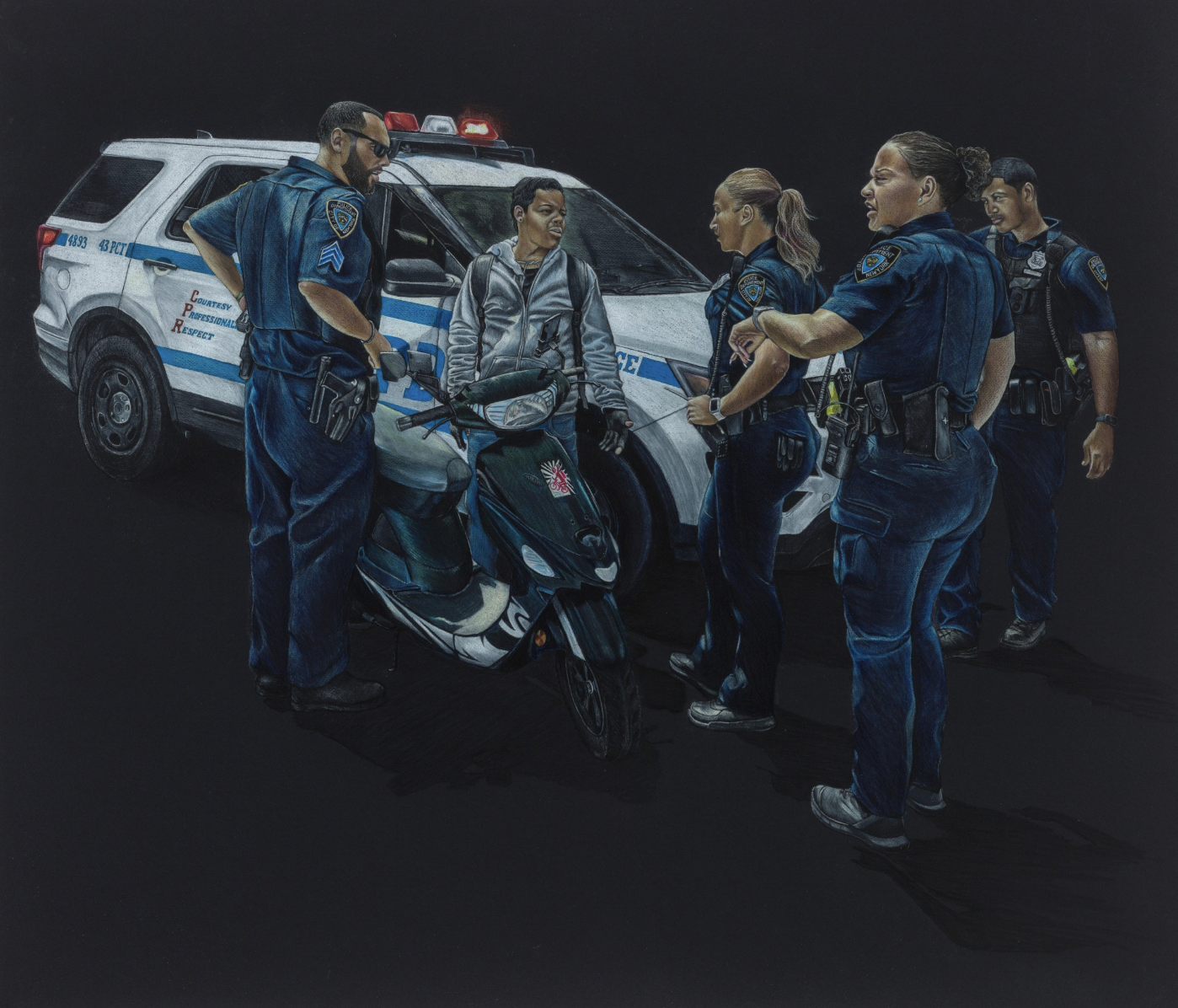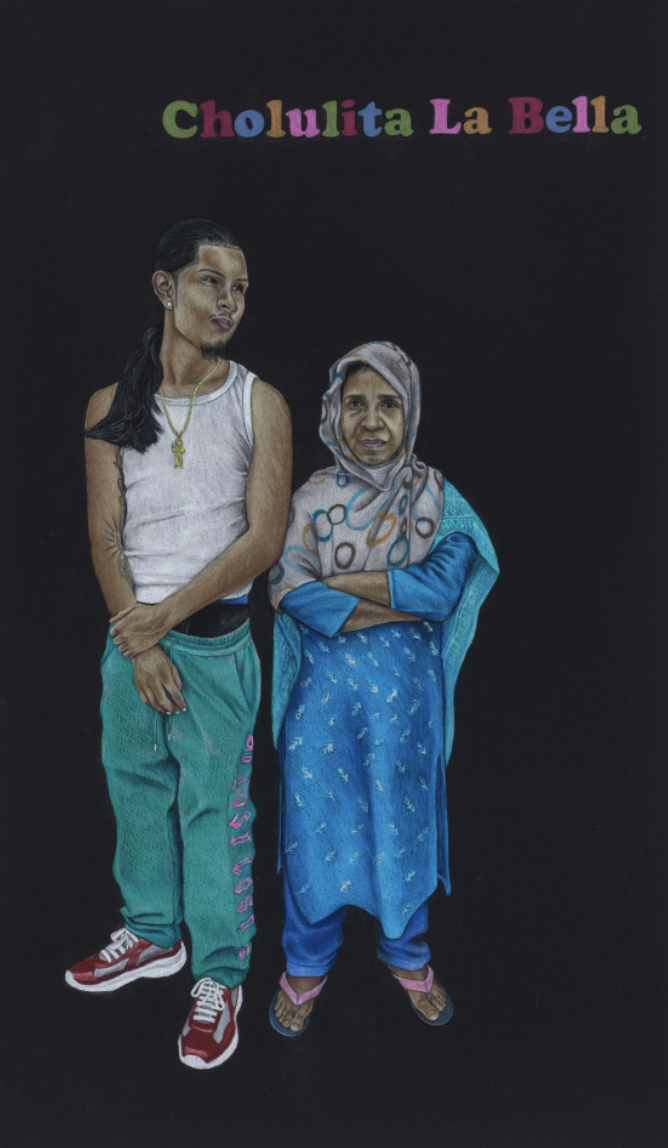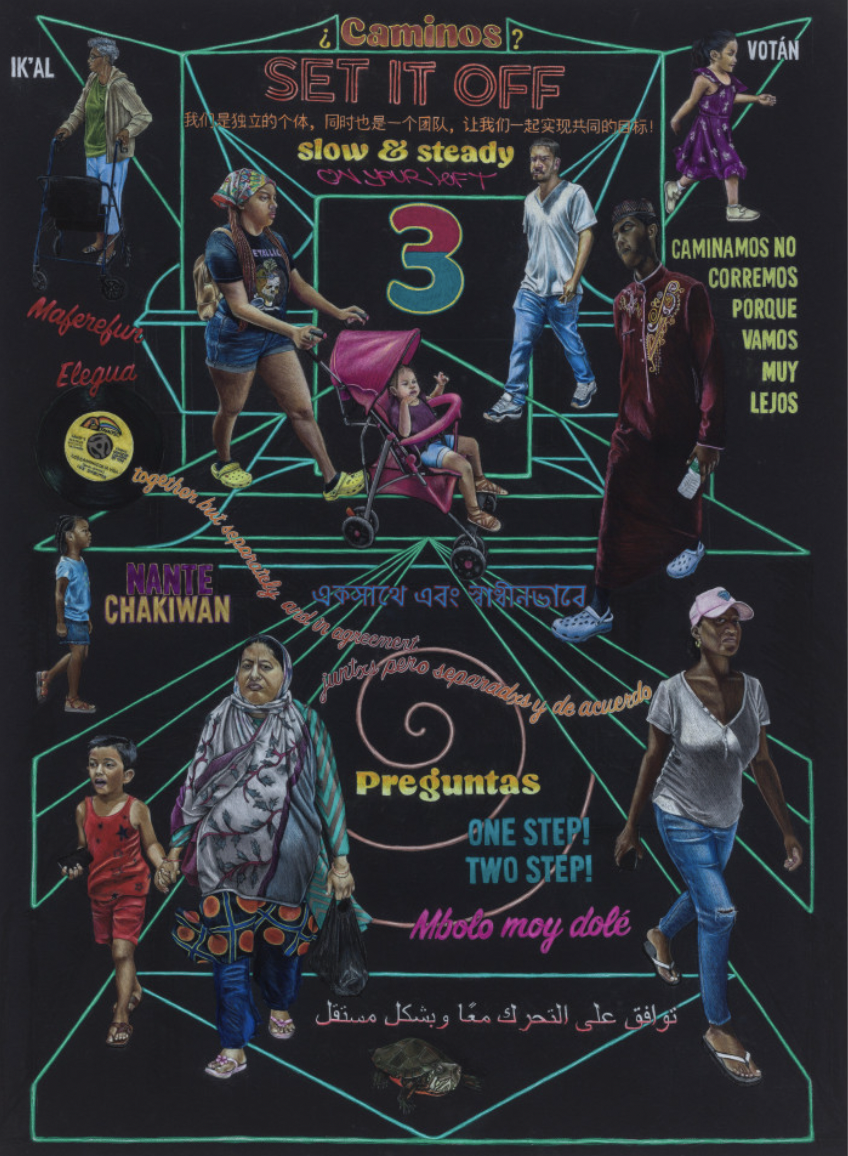Shellyne Rodriguez’s Third World Mixtapes: The Infrastructure of Feeling
Shellyne Rodriguez’s Third World Mixtapes: The Infrastructure of Feeling is the artist’s first solo exhibition with PPOW. The show features 22 colored pencil drawings on black paper. Drawing upon specific relationships from Rodriguez’s everyday life in the Bronx, her work transcends space, and time. Through her work at large, Rodriguez poses larger questions about our relationships with one another and our collective struggle for liberation.
Rodriguez is an artist, an educator, a writer, and a community organizer. In her practice, Shellyne draws heavily on her comrades and mentors: Ruth Wilson Gilmore, Sara Schulman, and Jasbir K. Puar, to name a few. True to her radical approach, Shellyne made the decision to utilize the gallery space for various community teach-ins during the duration of her show, facilitating key conversations surrounding abolition, anti-colonialism, anti-imperialism, and internationalism.
Shellyne Rodriguez, Jasbir K. Puar, “I’d Rather be a Flaming Insurgent”, 2023 (Courtesy of the artist and PPOW Gallery)
Shellyne Rodriguez, Ruth Wilson Gilmore’s Syllabus in Rehearsal, 2023 (Courtesy of the artist and PPOW Gallery)
Mariam Moran: I was elated to see the keffiyeh represented in your work. What do you believe is the importance of cross-cultural referencing, and collective liberation in your practice?
Shellyne Rodriguez: To me, it is more about how we have to live together on the periphery of empire, the reasons that bring us here, which are tied to imperialism and extraction. How to be global and local at the same time. Collective liberation is the roof of everything, it’s why an anti-colonial internationalism is really where I’m standing.
Philo Cohen: Can you speak a bit on the title of your show “Third World Mixtapes: The infrastructure of feeling”?
SR: The show is called “Third World Mixtapes: The Infrastructure of Feeling” the second part of the title, ‘The infrastructure of feeling’ comes from Ruth Wilson Gilmore. Essentially what it boils down to, the meaning, is, who in the canon of the ancestors of the liberation struggle one selects and amplifies, and who lives through and is put forward. At a moment inside the U.S., which is to say inside the empire, we are coming off the tail end of a severely co-opted Black Lives Matter movement. The Black radical tradition, the Black radical imagination is always in a see-saw, up and down. We are coming out of the counter-insurgency of our movement that began with Trayvon Martin’s murder in 2013, that sort of gave us Black Lives Matter before it got co-opted by NGOs and became a liberal reformist structure. That sort of plateaued and crashed in 2020, and now we are in this moment of ‘what is next?’
The playbook is the same. One of the last times we were in that ‘what is next’ moment, we got Nixon’s law and order, mass incarceration, the right wing and fascist clamped down. We are living through that clamping down moment right now, the rise of “multi-culti” fascism and rainbow imperialism with a Black NYC cop mayor, Laurie Lightfoot in Chi-town and at the same time we’re also dealing with Cop City in Atlanta. Fascism is here, the catastrophe has arrived like we said, so I bring it back to what does collective liberation look like? It looks like different things for different people, on different scales. For us, inside the empire, speaking from the position of a Black woman, of a Black Carribean Latina woman, but a Black woman just the same, my infrastructure of feeling relies on the Black radical tradition, specifically the Black leftist radical tradition. For me, that’s an anti-colonial and internationalist position. I feel like we’ve tried all the things. If it folds itself into the template of empire, it’s not useful, we must discard it, and that’s OK. We cannot fossilize something behind a vitrine just because.
Shellyne Rodriguez, BICOPs on the Third of May, 2022 (Courtesy of the artist and PPOW Gallery)
PC: What has been able to resist? What has not been able to be swallowed up?
SR: Anti-colonial positions don’t get swallowed up, by virtue of what the fuck they are. An internationalist position which I referenced in my zoom talk with Sohail Daulatzai, Nerdeen Kiswani and Dequi Kioni-Sadiki. We gave the example of Malcolm X versus Martin Luther King. MLK; for the majority of the civil rights movement was a liberal reformist movement that was in conversation with the nation-state. All of those negotiations locked Black Americans into a domestic conversation about a seat at a table that’s a cannibalistic table, “Who’s for dinner? It is us”. At the opposite, Malcolm X saw Black people in America as an internal domestic colony, as a part of the Third World. He was very influenced by the Bandung conference, he was seeing what was going on in the Third World Liberation movements. For Malcolm, Black people were part of a global majority, not some minority in the nation-state.
We all have the potential to become a Trojan horse. The Trojan horse narrative is what I'm interested in because that’s where our collective liberation can happen for those who are a diaspora here. We all leave a home, whether you are a recent immigrant, or a descendant of Operation Bootstrap like my people were, or a descendant of Jim Crow Great Migration like most Black Americans are, our collective liberation is part of that trojan horse-ness because we are in proximity.
PC: Can you give an example of how that narrative shows up in your work?
SR: In the piece The Common Denominator, the radiator acts as a common denominator. In my building, we all are so different from each other...whether you belong to a specific faith group or immigrant enclave, whatever you belong to. But what brings us together? The minute that boiler breaks down, so do those barriers, because we are able to come together based on our material needs.That’s local. If we scale up, the Strike MoMA protests gave us an example of the potential of interconnected struggles for collective liberation inside empire. Who or what becomes a common denominator in that situation? Board members. For example, Paula and James Crown fund education in the museum, they are also the owners of General Dynamics, which is the biggest defense contractor on the planet. So in 2021, there were bombings in Gaza and Yemen, the same make and model from General Dynamics. It just so happened that that year Colombia was in uprising which was a historic thing because Colombia has been a historic right-wing puppet of the U.S. Some of us, used to call it the Israel of South America. However, Colombia had a shift to the left and people were in the street, but General Dynamics sold military tanks to them the year before, so those military tanks were getting rolled out at the same time that bombs were falling in Palestine. Those people sitting on the board of MoMA all of the sudden became the radiator, and those neighbors became neighborhoods because we’ve got all the Colombians from Jackson Heights-Queens, the folks from Yemen in Morris Park and the Bronx, Bay Ridge came through, all the Palestinians. This becomes the common denominator. This is something we can do. There is a feasible target, there is a feasible way to apply pressure here in ways that our cousins back home cannot. Apply pressure! You are in New York and they all have corporate offices somewhere there, find it, do something, pressure from the inside. That is what I mean when I say Trojan Horse narrative.
Shellyne Rodriguez, The Common Denominator, 2023 (Courtesy of the artist and PPOW Gallery)
MM: Can you speak a little bit on your role as an educator, an organizer, and an artist within those institutional and corporate spaces, inside spaces of contradiction?
SR: I am in a gallery, I made a decision to engage in the contradiction, which is inevitable to sell my labor. In this particular case, the labor is my drawings, which have now been converted into luxury objects within a gallery. I’m a late bloomer in life, I went to college and finished my degrees in my mid 30’s, back to back BFA, MFA. When I got out of school I went straight into organizing. There was a lot of withholding my artistic practice. I was just engaging here and there without really pursuing it. Then, COVID happened; I had some space and time. The counter insurgency of 2020 really hurt me. I stepped back and stepped into my creative process; I started making drawings. Once you decide to make work you have to decide how it lives in the world. The ground we stand on is un-free ground, we are not free, nobody has freedom, so why would artwork have freedom? I am asking myself how do I make the work live beyond its commodification? It’s already going to be a commodified object. One way is cost effective reproduction. I can print these out and display them locally, turn the mixtapes into posters, and reprint the study guides as zines.The other side is the radical pedagogy that lives inside of it.
Each one of these things are political education tools. I am unapologetically didactic. Many people have come here on their own and felt things which I wanted them to feel, but there is another side to that experience where we can actually sit down and talk about the ideas that are there. When the show comes down next Saturday, you had an experience but you also learned something that you’re going to take with you and hopefully share and plant, letting that grow. In terms of the space, taking space is the most radical thing you can do. How do we transform any space and make it a thing where we can gather, congregate, talk and exchange ideas? A lot of that comes from The Groundings of my Brothers by Walter Rodney.
PC: I have been thinking about the books here. How did you come to those titles? What about the selection process for who shows up in your work and what books they have on their shelves, by their side, behind them?
SR: None of the books on this table I learned about in art school. This is all through movement people and people doing PhD’s in social sciences that once gave me a book. It came together through looking at footnotes. Everyone has to bring some type of the labor to the farm so that we can sustain our lives together. This is the watering hole.
[Editor’s note: Alongside public library books laid out on the table of Shellyne’s exhibits as well as free books gathered by Shellyne and Jasbir K. Puar for the audience to take home, Shellyne also put together a study guide for the show. A small booklet containing the entire bibliography of every book present in the drawings and beyond.]
Shellyne Rodriguez, BX Third World Liberation Mixtape no.3 (all about love), 2022 (Courtesy of the artist and PPOW Gallery)
MM: I happened to notice the direct gaze of the people you draw. I feel like I am making eye contact with them, having an unspoken dialogue with them. I am curious about that decision in your process.
SR: Everybody that is in here that is directly looking at you, it’s because I was in dialogue with them. Ninety percent of these folks are from my neighborhood. This little girl plays on my block in the park, Scar is the tough guy on the block, it took me a minute to ask him for a picture [laughs]. This woman is a lady who just walked by. Sometimes it is just people walking by that I just snap a picture of while chilling outside. Sometimes they are people that are directly engaging with me, people I see on a regular basis. Domingo is the pizza delivery guy on the block, Joseph is the knucklehead from around the corner with the bikes. Ranu works in the 99cent store, Gio is the youngest son of the bodega. Cholulita La Bella is the Mexican bodega. These two are from the Dominican barber shop that I have to walk past when I get to my apartment. When the weather is nice, that exact same hookah is outside. It was there last night when I walked home. What you might be sensing is that these are people I see everyday, so the way that they are looking at me is a look of familiarity, unless they are not looking at me at all in which case it is what it is.
Shellyne Rodriguez, Ranu and Gio (Cholulita La Bella), 2022 (Courtesy of the artist and PPOW Gallery)
Shellyne Rodriguez, Dos Tigueres, 2022 (Courtesy of the artist and PPOW Gallery)
PC: Can you speak to us about the connection between the subject and the sentences that comprise your work, sometimes also defining a work’s title?
SR: The titles are sometimes things sometimes not. This one for example is on the subject of defiant mobility. I was thinking about Harsha Walia’s Border and Rule: Global Migration, Capitalism, and the Rise of Racist Nationalism. Thinking about her ideas of border imperialism, I thought about how Domingo delivers pizzas on his scooter, hustling for not a lot of money and a whole lot of risk. That man had to endure that border imperialism and now he's here enduring NYPD but he will do it. and he will bring his cousins too! Defiant! No one will stop them from coming. I put Domingo next to Joseph who reps biker boys of the city who the NYPD is constantly cracking down on. NYPD come on Tuesday, Joseph will be back Wednesday. We have our joy, regardless. This sentence about defiant mobility is about liberated life and freedom. How we create liberated life ways. If you are waiting for a utopian freedom to come, you might as well wait for heaven. How are we creating freedom now within the scales we can? The possibilities for freedom existing in the different ways we can weave them in. Those people are prime examples of that.
Shellyne Rodriguez, On the Subject of Defiant Mobility, 2022 (Courtesy of the artist and PPOW Gallery)
PC: Lastly, I’d love to hear about the Buddy Esquire Hip Hop imageries used as graphic layout in your Mixtapes works?
SR: I consider the Mixtape works to be landscapes. Landscapes in the way that you are waiting in line to pay for your juice in the bodega, peering through the front glass, looking at the neon on the glass. There are kids running by, after school, a car passes by playing music, there is a dog barking. All of the hustle and bustle of the neighborhood. Neighborhood not just meaning your immediate surrounding, but rather neighborhood encompassing a few blocks around where you are standing. The structure of those landscapes is based upon Buddy Esquire’s Hip Hop flyers which predates the commodification of Hip Hop. I am very interested in the idea of Hip Hop from below in the way that social sciences talk about internationalism from below. Buddy Esquire called his flyer designs Neo Deco and you can see the architectural elements within them. He is thinking about boxing flyers, Apollo Theater flyers. The architectural frame of it forms a container.
I am interested in talking about the legacy of Hip Hop and who inherits that legacy. Not just Hip Hop as a cultural thing but as a revolutionary movement. Hip Hop is a political thing too because it emerges during Neoliberal turn; there is the deindustrialization of New York, all migrants who came at that time, who came for factory work are out of work overnight. The opioid epidemic, and COINTELPRO, which murdered, framed, or imprisoned all of our liberation fighters. When there was nowhere to turn, as a people, we turned to art, we turned to culture. Hip Hop emerges at this time. We can think of it through abolition in the way that Ruth Wilson Gilmore says it is not just an unmaking but a remaking as well. We rejuvenate, we remake ourselves through culture.
Hip Hop holds this legacy and becomes a container. Who is here now, alongside the Black Americans, Puerto Ricans, and Caribbean folks who made Hip Hop, are folks from Bangladesh, folks from Ghana, Senegal, Nigeria, a lot of folks from Indian communities, Quechua speakers, the Andean community from Ecuador, lots of folks from Yemen in the Bronx. It is about reflecting who these people are, reflecting the multiplicity of languages as well. You see the Spanish, you see the Bangla, you see the Arabic, you see the Chinese. In a lot of ways, this is me thinking about translating our political materials locally, as an organizer. It’s an invitation too. I'm inviting you to this flyer, I am inviting you to cast a spell with me.
Shellyne Rodriguez, BX Third World Mix Tape no.4, Caminos (Slow and Steady), 2022 (Courtesy of the artist and PPOW Gallery)
List of remaining events
Tuesday, April 18th, 6-8pm
Teach-in with Jasbir K. Puar Terrorist Assemblages
Thursday, April 20th, 6-8pm
Film Screening of "The World like a Jewel in the Hand" and a discussion with Ariella Aïsha Azoulay
Saturday, April 22nd
Closing block party with UPTOWN VINYL SUPREME
All events are free. Hosted at PPOW Gallery in New York.
For a complete list of events that were hosted in the exhibition space please click here.







